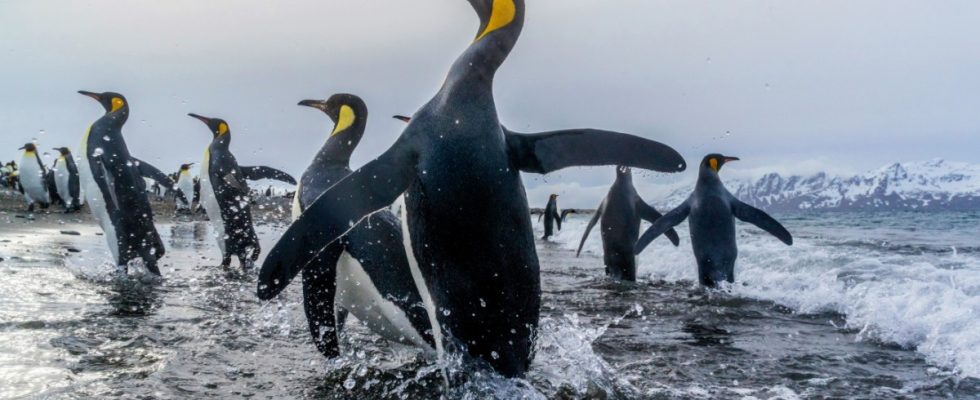Bird flu is spreading to ever more remote regions of the world – and is now becoming a threat to penguins. So far, Antarctica, Australia and Oceania have been spared. But now scientists from the polar research organization British Antarctic Survey (BAS) have discovered the first cases on Bird Island in the Southern Ocean. For the first time on September 17th, they came across a brown skua skua that was stumbling suspiciously, reports seabird ecologist Norman Ratcliffe from the BAS. Since then, researchers have found 29 dead birds of the same species. They took samples from three animals and sent them to a laboratory in Great Britain. The test confirmed the suspicion: the bird flu pathogen, the influenza A virus H5N1, was found in the animals. The pathogen is highly contagious and has already killed millions of birds worldwide.
The animals on Bird Island had not previously come into contact with this pathogen. Environmental experts therefore fear mass extinctions. The small island, which is part of South Georgia and the South Sandwich Islands, can only be reached by boat. It is located about 1,400 kilometers southeast of the Falkland Islands, about the same distance from the Antarctic mainland. This isolation has meant that the wildlife here is special: “Bird Island is one of the most species-rich nature reserves in the world,” says the website of the research station there. 50,000 pairs of penguins breed on the sub-Antarctic island. Five species such as Emperor and Adelie penguins are only found there. Tens of thousands of fur seals, a type of seal, mate on Bird Island. And many of the seabirds that live there are on the endangered or threatened list, including albatrosses.
The virus threatens not only birds, but also many mammal species
Some penguin species are now particularly threatened by the virus, said Timm Harder, head of the Institute for Virus Diagnostics at the Friedrich Loeffler Institute in Greifswald, to the German Press Agency: “If the viruses break into the large Antarctic penguin populations from South America If you do, you have to expect dire consequences.”
The brown skua probably brought bird flu from South America. The migratory bird winters in the northern hemisphere and returns to Antarctic islands to breed. He usually lays it down a stopover in South America a. Bird flu has also been raging there since the end of last year. Thousands of dead pelicans, penguins, sea otters, seals and other marine life have been discovered along the Pacific coast in Peru and Chile. Dead sea lions were discovered on the South American Atlantic coast in Uruguay and Argentina in the summer. In total, the authorities in South America have so far registered around 20,000 dead sea lions, More than 500,000 seabirds died from the virus. The bird flu virus has even reached the Galápagos Islands off the coast of Ecuador. In migratory birds, the virus traveled more than 6,000 kilometers in just three months and finally reached the southernmost tip of Tierra del Fuego. Already Experts warned in September therefore about the possible risk of “devastating effects on seabird colonies” in the Southern Ocean.
The current outbreak, which began in October 2021, is the longest wave of bird flu documented to date. Not only birds are affected worldwide, but also mammal species such as raccoons, foxes, bears and martens domestic cats. Bird flu cases in mink farms worry experts because they fear that the pathogen could jump from mammal to mammal. For humans it is currently considered largely harmless.
If bird flu now spreads to Antarctica, Australia and Oceania will be the only regions where there are no known cases. However, bird flu expert Harder assumes that it will not stay that way: “It’s just a matter of time.” At least from South Georgia, bird flu will not make it to the Antarctic continent, says BAS ecologist Norman Ratcliffe. “The birds go there to breed. I wouldn’t expect them to move further south.” But that is not a reason to give the all-clear: the virus has shown that it can easily bridge large distances. “The risk is that infected birds can cross large parts of the ocean, we’re talking 800 miles, in just a few days,” says Ratcliffe. “There is a latency period of a few days before they show symptoms that affect their motor skills and coordination.”

